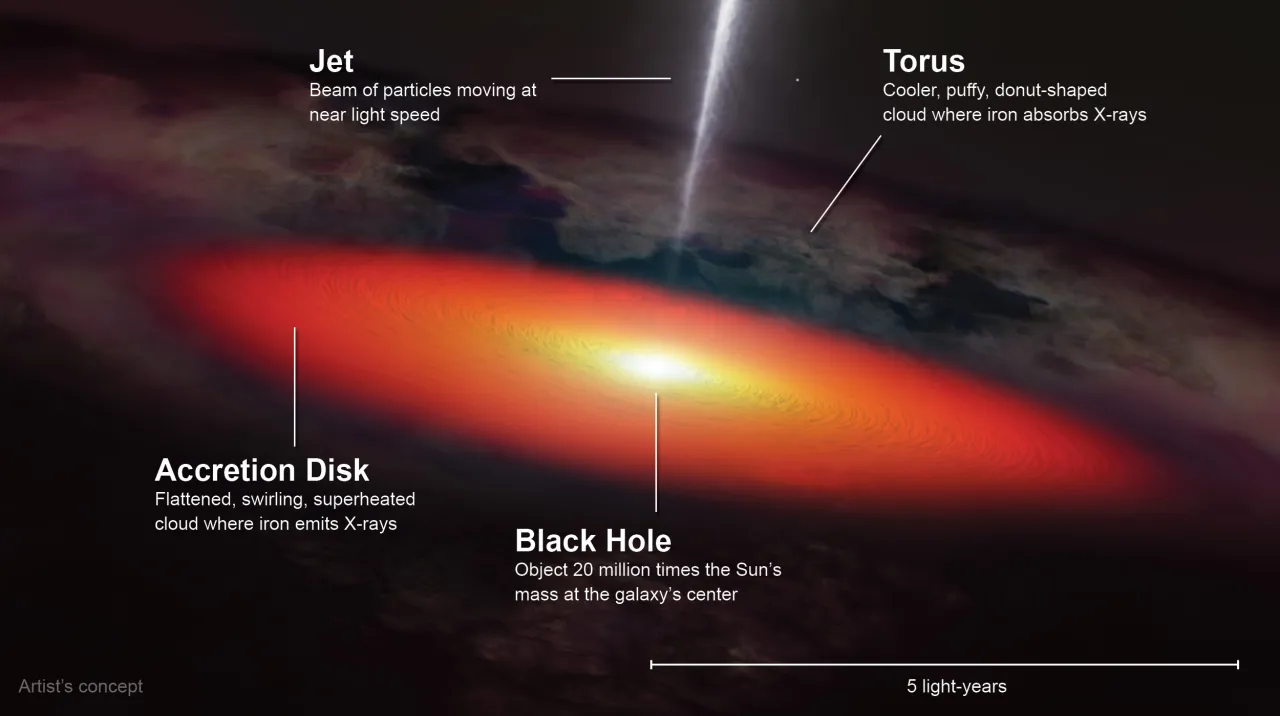Reviewed by Lexie CornerMay 9 2024
A group of scientists from NASA and JAXA examined the massive black hole in the center of galaxy NGC 4151 using XRISM (X-Ray Imaging and Spectroscopy Mission).
 This artist’s concept shows the possible locations of iron revealed in XRISM’s X-Ray spectrum of NGC 4151. Scientists think X-Ray-emitting iron is in the hot accretion disk, close to the black hole. The X-Ray-absorbing iron may be further away, in a cooler cloud of material called a torus. Image Credit: NASA's Goddard Space Flight Center Conceptual Image Lab
This artist’s concept shows the possible locations of iron revealed in XRISM’s X-Ray spectrum of NGC 4151. Scientists think X-Ray-emitting iron is in the hot accretion disk, close to the black hole. The X-Ray-absorbing iron may be further away, in a cooler cloud of material called a torus. Image Credit: NASA's Goddard Space Flight Center Conceptual Image Lab
XRISM’s Resolve instrument captured a detailed spectrum of the area around the black hole; the peaks and dips are like chemical fingerprints that can tell us what elements are present and reveal clues about the fate of matter as it nears the black hole.
Brian Williams, Project Scientist, Goddard Space Flight Center
XRISM, pronounced "crism," is spearheaded by JAXA (Japan Aerospace Exploration Agency) in partnership with NASA, supplemented by contributions from ESA (European Space Agency). The mission was launched on September 6, 2023. Resolve, the microcalorimeter spectrometer integral to the mission, was jointly developed by NASA and JAXA.
Spiral galaxy NGC 4151 is located in the northern constellation Canes Venatici, approximately 43 million light-years away. Its central supermassive black hole is over 20 million times as big as the Sun.
The galaxy is active, which accounts for its exceptionally bright and fluctuating center. The variability is produced as gas and dust spiraling toward the black hole heat up, creating an accretion disk around it due to frictional and gravitational forces.
A portion of the material on the black hole's edge generates twin jets of particles that shoot out at almost the speed of light from either side of the disk. Around the accretion disk is a fluffy cloud of material shaped like a donut, known as a torus.
NGC 4151 is among the nearest known active galaxies. Scientists can learn more about the interaction between black holes and their surroundings by examining data from other missions, such as NASA's Chandra X-Ray Observatory and Hubble Space Telescope. This information can help them understand how supermassive black holes in galactic centers grow throughout cosmic time.
The galaxy was a perfect early target for XRISM because of its unusual X-Ray brightness.
NGC 4151's resolve spectra show an iron emission line, or sharp peak, at energies somewhat less than 6.5 keV. Astronomers believe that X-Rays from hot, flaring regions around black holes account for a large portion of the power of active galaxies.
X-Rays bouncing off cooler gas in the disk cause iron there to fluoresce, creating a specific X-Ray peak. This makes it possible for astronomers to depict the disk and eruptive regions that are much closer to the black hole more clearly.
There are other dips in the spectrum about 7 keV as well. These dips were also created by iron in the torus, but by X-Ray absorption rather than emission. This is because the material there is far colder than the disks. The energy of all this radiation is around 2,500 times greater than that of the light that human eyes can detect.
Among the elements that XRISM can identify is iron. Depending on the source, the telescope can also detect argon, calcium, sulfur, and other elements. Astrophysicists can learn different things about the cosmic occurrences dispersed throughout the X-Ray sky from each one.
XRISM is a joint NASA/JAXA mission in which ESA is a collaborator. The Canadian Space Agency (CSA) contributes to science as part of NASA.